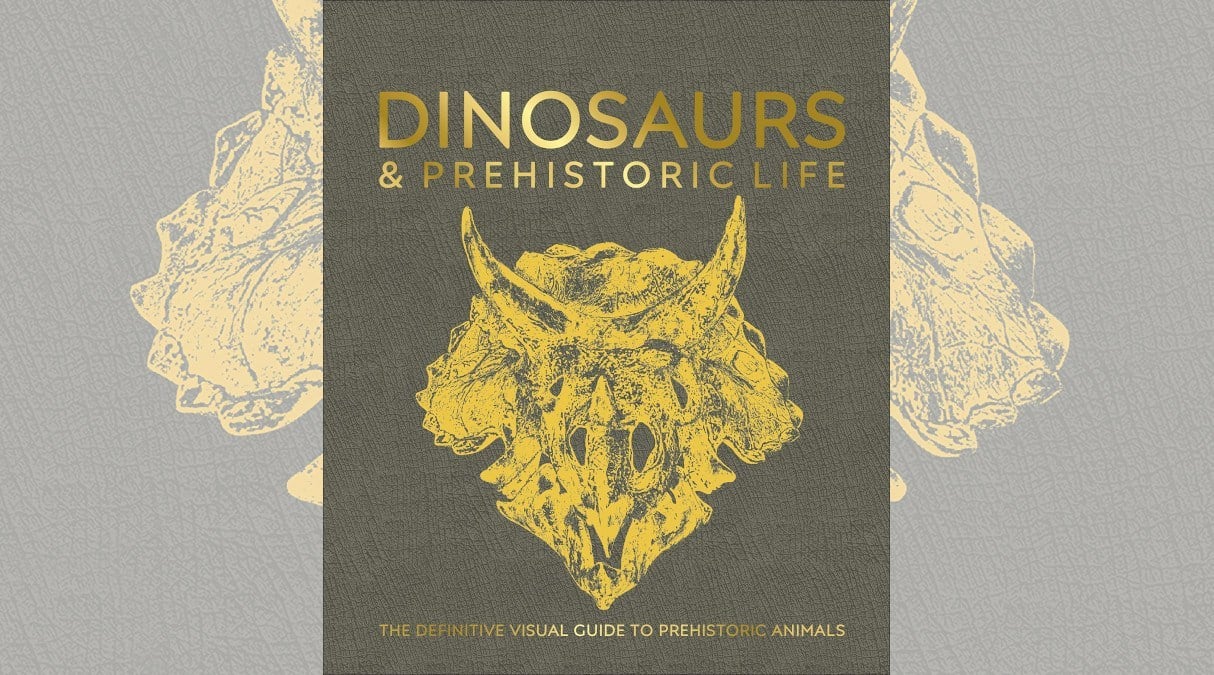This Week’s Word is “Prehistory.”
In the two years or so that I have been writing my Word Wednesday column, I’ve reviewed several DK dinosaur-related books. These were mainly aimed at children, and, in dinosaur terms, were mere Compsognathus. ‘Dinosaurs & Prehistoric Life,’ by comparison, is a Diplodocus; huge and liable to squash you if it falls on your head.
What is Dinosaurs & Prehistoric Life?
Starting with the formation of the Earth and running up to the quaternary period, Dinosaurs & Prehistoric Life contains everything you could ever want to know about life on earth, before the arrival of humans. It’s a weighty hardback, totaling over 400 pages, filled with DK’s trademark blend of beautiful photos and informative text.
The book is broken down into two main sections, one much smaller than the other. The first 50 pages are dedicated to “Young Earth” the rest of the book, “Life on Earth.”
Young Earth.
Opening with the formation of the Earth and Moon, the book’s opening pages are dedicated to geology rather than paleontology. It details how the atmosphere was formed, how continents appeared, and the science of plate tectonics, before going onto very early life forms and how they are categorized. This section also explains the fossilization process, the world’s key fossil sites, and, a geekily marvelous, geological timescale.
This is a huge book and one not really aimed at children, though interested older children will definitely find much to enjoy. There’s a lot of detail crammed into this book and lots of scientific information. Where sidebar texts on a lot of DK books might be about “messy meat-eaters,” this book has boxes entitled “magnetostratigraphy.”
Life on Earth.
The meat of the book, broken down into 14 epochs, some of which you’ll be familiar with and others not so much. Some of them you’d be forgiven for thinking were the names of comic book villains.
- Archean
- Proterozoic
- Cambrian
- Ordovician
- Silurian
- Devonian
- Carboniferous
- Permian
- Triassic
- Jurassic
- Cretaceous
- Paleogene
- Neogene
- Quaternary
Some of these sections only have a few pages dedicated to them (Archean and Proterozoic) others have significantly more (Jurassic and Cretaceous.) (Admit it, you’re humming the tune to Jurassic Park now.)
Each section follows the same general pattern, opening with an overview of the period covered, detailing the prevailing climate and the state of continental plates. There is also a timeline of lifeforms, broken down into the bands microscopic life, plants, invertebrates, and vertebrates.
The larger epoch sections are further sub-divided by these types too. For example, the Jurrasic section has plant, invertebrate, and vertebrate subsections. Each of these subsections is filled with a catalog of species that were around at the time. Entries may be a full double-page spread for the more famous and well-known dinosaurs or perhaps just a small picture and paragraph for a lowly plant. The depth and breadth of information in the book cannot be over-sold. It’s an impressive body of work.
Dotted throughout the books, is information about the anatomy of dinosaurs, biographies of important paleontologists, or more information about the sites where fossils of a particular dinosaur are found.
The book closes out with a detailed look at our hominid ancestors and an extensive glossary and index.
Why Read Dinosaurs & Prehistoric Life?
The study of dinosaurs is an ever-evolving field as new discoveries are made and old evidence reconsidered. This book draws all the latest thinking together into one impressive tome.
If you’re looking for a comprehensive manual about prehistoric life, all prehistoric life, not just the fearfully great lizard ones, then you don’t need to look past this book. It has all of DK’s publishing experience poured into it, backed up by a cohort of expert writers. There are over 30 contributors from great academic institutions across the globe.
Like all DK books, it’s fabulous to flick through. You will inevitably find something that grabs your attention. One thing that never fails to surprise me is how thinking about dinosaurs has changed since I first learned about them and this is a great way to find out about the current understanding of those old childhood favorites.
This book is not directly aimed at children and its text is quite technical but if you have an older child (around 11 and upwards) with a keen interest in the subject, they will surely love Dinosaurs & Prehistoric Life.
If you’d like to pick up a copy of Dinosaurs & Prehistoric Life you can do so here, in the US (published 10/8) and here, in the UK.
If you enjoyed this review, do check out my other Word Wednesday posts.
Disclosure: I received a copy of this book in order to write this review.








